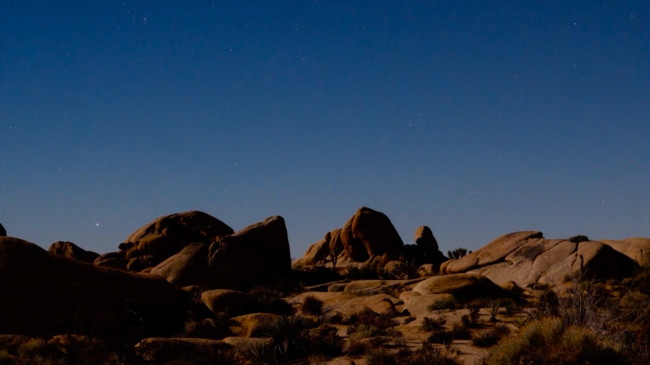This page describes a video The Culmination of Canopus
Video caption:
Honourable mention in the 2022 IAU OAE Astrophotography Contest, category Time lapses of celestial patterns.
This time-lapse video was shot in January 2018 from the Joshua Tree National Park, USA, and follows the path of Canopus, the second-brightest star in the night sky, as it moves from left to right, almost touching the horizon. The landscape is illuminated by the Moon.
Canopus is associated with the rudder of the ancient Argo constellation, the Ship, nowadays split into the three modern constellations Vela, Puppis and Carina, the last of which contains Canopus.
Owing to its brightness, Canopus has caught the attention of several cultures around the world throughout history. For instance, the Navajo people of North America named the star as the Coyote, and say that the coyote took part in the creation of the Universe. The Kalapalo people of Brazil associated Canopus with a duck, with other bright stars making up the body parts of the animal. The appearance of Canopus in the sky indicates the coming of the rainy season.
Scroll to captions in other languages
Video credit:
Fabrizio Melandri/IAU OAE
DOI: 10.5281/zenodo.7425676
Related glossary terms:
Constellation
Categories:
Naked Eye Astronomy
Video license: Creative Commons Attribution 4.0 International (CC BY 4.0) Creative Commons Attribution 4.0 International (CC BY 4.0) icons
The media file captions presented on the OAE website were written, translated and reviewed by a collective effort from the OAE, the OAE Centers and Nodes, the OAE National Astronomy Education Coordinators (NAECs) and other volunteers. You can find a full list of credits for our translation project here. All media file captions are released under a Creative Commons CC BY-4.0 license and should be credited to "IAU OAE". The media files themselves may have different licenses (see above) and should be credited as listed above under "credit".
If you notice a factual error in this caption or an error in any of its translations then please get in touch.
Captions in Different Languages:
Video caption: ২০২২ আইএইউ ওএই অ্যাস্ট্রোফটোগ্রাফি প্রতিযোগিতায় সম্মানজনক উল্লেখ, স্বর্গীয় নিদর্শনগুলির টাইম ল্যাপস বিভাগ।
এই টাইম-ল্যাপস ভিডিওটি ২০১৮ সালের জানুয়ারিতে জোশুয়া ট্রি ন্যাশনাল পার্ক, ইউএসএ থেকে শ্যুট করা হয়েছিল এবং রাতের আকাশের দ্বিতীয়-উজ্জ্বল তারা ক্যানোপাসের পথ অনুসরণ করে, যখন এটি বাম থেকে ডানে চলে, প্রায় দিগন্ত স্পর্শ করে। ল্যান্ডস্কেপ চাঁদ দ্বারা আলোকিত হয়.
ক্যানোপাস প্রাচীন আর্গো নক্ষত্রমণ্ডলের রুডারের সাথে যুক্ত, জাহাজ, বর্তমানে তিনটি আধুনিক নক্ষত্র ভেলা, পপিস এবং ক্যারিনাতে বিভক্ত, যার শেষটিতে ক্যানোপাস রয়েছে।
এর উজ্জ্বলতার কারণে, ক্যানোপাস ইতিহাস জুড়ে বিশ্বের বিভিন্ন সংস্কৃতির দৃষ্টি আকর্ষণ করেছে। উদাহরণস্বরূপ, উত্তর আমেরিকার নাভাজো লোকেরা নক্ষত্রটির নাম দিয়েছে কোয়োট, এবং বলে যে কোয়োট মহাবিশ্ব সৃষ্টিতে অংশ নিয়েছিল। ব্রাজিলের কালাপালোর লোকেরা ক্যানোপাসকে হাঁসের সাথে যুক্ত করেছিল, অন্যান্য উজ্জ্বল নক্ষত্রের সাথে প্রাণীর দেহের অংশগুলি তৈরি করে। আকাশে ক্যানোপাসের উপস্থিতি বর্ষার আগমনের ইঙ্গিত দেয়।
Video credit: ফ্যাব্রিজিও মেলান্দ্রি/আইএইউ ওএই
Related glossary terms: Constellation Caption translation status: Not yet approved by a reviewer
Caption translators: Raktim Mukherjee
Video caption: Lobende Erwähnung im IAU OAE Astrofoto-Wettbewerb 2022, Kategorie Zeitraffervideos von Himmelsmustern.
Dieses Zeitraffervideo wurde im Januar 2018 im Joshua-Tree-Nationalpark in den USA aufgenommen und zeigt die Bahn von Canopus, dem zweithellsten Stern am Nachthimmel, wie er sich von links nach rechts über den Himmel bewegt und dabei fast den Horizont berührt. Die Landschaft wird vom Mond beleuchtet.
Canopus wird mit dem Ruder im antiken Sternbild des Schiffs Argo in Verbindung gebracht, das heute in die drei modernen Sternbilder Vela, Puppis und Carina aufgeteilt ist, wobei Canopus in letzterem enthalten ist.
Aufgrund seiner Helligkeit hat Canopus im Laufe der Geschichte die Aufmerksamkeit verschiedener Kulturen auf der ganzen Welt auf sich gezogen. Das nordamerikanische Volk der Navajo beispielsweise nannte den Stern den Kojoten. Nach ihrer Vorstellung war der Kojote an der Erschaffung des Universums beteiligt. Das Kalapalo-Volk in Brasilien assoziierte Canopus mit einer Ente, wobei andere helle Sterne die Körperteile des Tieres darstellten. Das Erscheinen von Canopus am Himmel deutet auf den Beginn der Regenzeit hin.
Video credit: Fabrizio Melandri/IAU OAE
Related glossary terms: Sternbild Caption translation status: Not yet approved by a reviewer
Caption translators: Carolin Liefke
Video caption: Menzione d'onore al concorso di astrofotografia IAU OAE 2022, categoria Riprese temporizzate di disegni celesti.
Questo video in time-lapse è stato girato nel gennaio 2018 dal Joshua Tree National Park, negli Stati Uniti, e segue il percorso di Canopo, la seconda stella più luminosa del cielo notturno, mentre si muove da sinistra a destra, quasi toccando l'orizzonte. Il paesaggio è illuminato dalla Luna.
Canopo è associato al timone dell'antica costellazione di Argo, la Nave, oggi suddivisa nelle tre costellazioni moderne Vela, Puppis e Carina, l'ultima delle quali contiene Canopo.
Grazie alla sua luminosità, Canopo ha attirato l'attenzione di diverse culture del mondo nel corso della storia. Per esempio, i Navajo del Nord America chiamano la stella Coyote e sostengono che il coyote abbia partecipato alla creazione dell'Universo. Il popolo brasiliano dei Kalapalo associava Canopo a un'anatra, mentre altre stelle luminose costituivano le parti del corpo dell'animale. La comparsa di Canopo nel cielo indica l'arrivo della stagione delle piogge.
Video credit: Fabrizio Melandri/IAU OAE
Related glossary terms: Costellazione Caption translation status: Approved by a reviewer
Caption translators: Giuliana Giobbi
Caption reviewers: Rodolfo Canestrari
Video caption: 2022 年国际天文学联合会 OAE 天体摄影竞赛 "天体图案的时间流逝 "类别荣誉奖。
这段延时视频于 2018 年 1 月在美国约书亚树国家公园拍摄,沿着老人星的轨迹,它是夜空中第二亮的星,从左到右移动,几乎触及地平线。月亮照亮了整个景观。
老人星与古老的南船座(Argo)的船舵有关,如今,南船座已拆分为三个现代星座:船帆座(Vela)、船尾座(Puppis)和船底座(Carina),老人星位于船底座。
由于它的亮度,在历史上,老人星吸引了世界各地文化的关注。例如,北美洲的纳瓦霍人将这颗恒星命名为 "郊狼",并说郊狼参与了宇宙的创造。巴西的卡拉帕洛人将老人星与鸭子联系在一起,其他明亮的星星构成了鸭子的身体部位。老人星出现在天空预示着雨季的到来。
Video credit: Fabrizio Melandri/IAU OAE
Related glossary terms: 星座 Caption translation status: Not yet approved by a reviewer
Caption translators: Hu Xueying
Video caption: 2022 年國際天文學聯合會 OAE 天體攝影競賽 "天體圖案的時間流逝 "類別榮譽獎。
這段延時視頻於 2018 年 1 月在美國約書亞樹國家公園拍攝,沿著老人星的軌跡,它是夜空中第二亮的星,從左到右移動,幾乎觸及地平線。月亮照亮了整個景觀。
老人星與古老的南船座(Argo)的船舵有關,如今,南船座已拆分為三個現代星座:船帆座(Vela)、船尾座(Puppis)和船底座(Carina),老人星位於船底座。
由於它的亮度,在歷史上,老人星吸引了世界各地文化的關注。例如,北美洲的納瓦霍人將這顆恆星命名為 "郊狼",並說郊狼參與了宇宙的創造。巴西的卡拉帕洛人將老人星與鴨子聯繫在一起,其他明亮的星星構成了鴨子的身體部位。老人星出現在天空預示著雨季的到來。
Video credit: Fabrizio Melandri/IAU OAE
Related glossary terms: 星座 Caption translation status: Not yet approved by a reviewer
Caption translators: An automated transliteration from the simplified Chinese translation by - Hu Xueying









